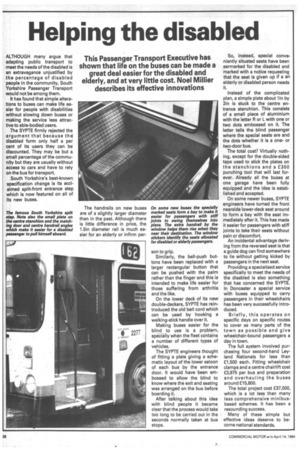Helping the disabled
Page 40

If you've noticed an error in this article please click here to report it so we can fix it.
This Passenger Transport Executive has shown that life on the buses can be made a great deal easier for the disabled and elderly, and at very little cost. Noel Millier describes its effective innovations
ALTHOUGH many argue that adapting public transport to meet the needs of the disabled is an extravagance unjustified by the percentage of disabled people in the community, South Yorkshire Passenger Transport would not be among them.
It has found that simple alterations to buses can make life easier for people with disabilities without slowing down buses or making the service less attractive to able-bodied users.
The SYPTE firmly rejected the argument that because thd disabled form only half a per cent of its users they can be discounted. They may be but a small percentage of the community but they are usually without access to cars and have to rely on the bus for transport.
South Yorkshire's best-known specification change is its acclaimed split-front entrance step which is now featured on all of its new buses. The handrails on new buses are of a slightly larger diameter than in the past. Although there is little difference in price, the 1.5in diameter rail is much easier for an elderly or infirm per son to grip.
Similarly, the bell-push but tons have been replaced with a larger rectangular button that can be pushed with the palm rather than the finger and this is intended to make life easier for those suffering from arthritis and the like.
On the lower deck of its new double-deckers, SYPTE has reintroduced the old bell cord which can be used by hooking a walking-stick handle over it.
Making buses easier for the blind to use is a problem, specially when the fleet contains a number of different types of vehicles.
The SYPTE engineers thought of fitting a plate giving a schematic layout of the lower saloon of each bus by the entrance door. It would have been embossed to allow the blind to know where the exit and seating was arranged on the bus before boarding it.
After talking about this idea with blind people it became clear that the process would take too long to be carried out in the seconds normally taken at bus stops. So, instead, special conveniently situated seats have been earmarked for the disabled and marked with a notice requesting that the seat is given up if a an elderly or disabled person needs It.
Instead of the complicated plan, a simple plate about lin by 2in is stuck to the centre entrance stanchion. This consists of a small piece of aluminium with the letter R or L with one or two dots embossed on it. The letter tells the blind passenger where the special seats are and the dots whether it is a oneor two-door bus.
The total cost? Virtually nothing, except for the double-sided tape used to stick the plates on the stanchions and a £300 punching tool that will last forever. Already all the buses at one garage have been fully equipped and the idea is established and accepted.
On some newer buses, SYPTE engineers have turned the front nearside lower-deck seat around to form a bay with the seat immediately after it. This has made it easier for passengers with stiff joints to take their seats without pain or discomfort.
An incidental advantage deriving from the reversed seat is that a guide dog can find somewhere to lie without getting kicked by passengers in the next seat.
Providing a specialised service specifically to meet the needs of the disabled is also something that has concerned the SYPTE. In Doncaster a special service with buses equipped to carry passengers in their wheelchairs has been very successfully introduced.
Briefly, this operates on specific days on specific routes to cover as many parts of the town as possible and give wheelchair-bound passengers a day in town.
The full system involved purchasing four second-hand Leyland Nationals for less than £1,500 each. Fitting wheelchair clamps and a centre chairlift cost £3,975 per bus and preparation and overhauling the buses around £15,800.
The total project cost £37,000, which is a lot less than many less comprehensive minibusbased schemes. It has been a resounding success.
Many of these simple but effective ideas deserve to become national standards.




























































































